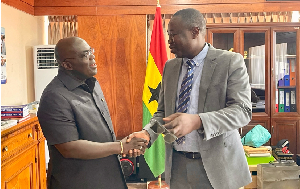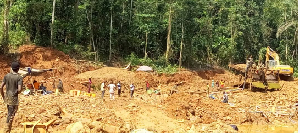– A Way to Reduce Some Water Borne Diseases
Nearly 80 percent of disease in developing countries is linked to bad water and sanitation. Now a scientist at Michigan Technological University has developed a simple, cheap way to make water safe to drink, even if it's muddy.
It's easy enough to purify clear water. The solar water disinfection method, or SODIS, calls for leaving a transparent plastic bottle of clear water out in the sun for six hours. That allows heat and ultraviolet radiation to wipe out most pathogens that cause diarrhea, a malady that kills 4,000 children a day in Africa.
It's a different story if the water is murky, as it often is where people must fetch water from rivers, streams and boreholes. "In the developing world, many people don't have access to clear water, and it's very hard to get rid of the suspended clay particles," says Joshua Pearce, an associate professor of materials science and engineering. "But if you don't, SODIS doesn't work. The microorganisms hide under the clay and avoid the UV."
Thus, to purify your water, you first have to get the clay to settle out, a process called flocculation. Working with student Brittney Dawney of Queen's University in Ontario, Pearce discovered that one of the most abundant minerals on Earth does this job very well: sodium chloride, or simple table salt. Salt is inexpensive and available almost everywhere. And it doesn't take very much to make muddy water clear again.
"The water has a lower sodium concentration than Gatorade (an energy drink)," Pearce says. This would still be too much salt to pass muster as American tap water, but American tap water is not the alternative.
"I've drunk this water myself. If I were somewhere with no clean water and had kids with diarrhea, and this could save their lives, I'd use this, no question," he says. Salt works best when the suspended particles are a type of clay called bentonite. The technique doesn't work as well with other kinds of clay. However, by adding a little bentonite with the salt to water containing these different clays, most of the particles glom together and settle out, creating water clear enough for SODIS treatment. Pearce and Dawney are running more tests on water containing various types of clays, and they are also investigating different soil types across Africa to see where their methods might work the best.
Original article was in ScienceDaily (May 1, 2012)-http://www.sciencedaily.com/releases/2012/05/120501134315.htm
Comments This is a simple technology and if awareness is drawn in addition to proper practice could help save lives - just using sunlight and transparent plastic bottles in a situation of water which is clear or have very low suspended particles or sediments. In addition, the use of plastic bottles could promote the recycling of plastic bottles which are abundant everywhere in Ghana. This technology is green and could lessen environmental impacts. It could even be applied in areas with poor quality water or during water borne epidemics such as such as typhoid fever, cholera, leptospirosis and hepatitis A, diarrhea, dysentery, etc.
Though, it is known that heating kills germs however overheating of water without capturing and condensing the steam back to the boiled water could pose the risk/threat of possible concentration of dangerous minerals such as heavy metals. Hence, it is advisable to boil contaminated water in the shortest possible period which could be difficult to do in some cases. Moreover, boiling result in the removal of more gases trapped in water.
This simple technology of exposing water in a plastic bottle with a cover to kill germs eliminates or reduces water loss by evaporation which could be encountered during boiling. While using this simple technology, it is advisable to leave some space on top of the water in the tightly covered plastic bottle for the trapped gases in the water to occupy while heated in the sunlight. Also, opening the plastic bottle with the water while hot for use after it has received sufficient solar energy is recommended; it is at this point that reasonable amount of the trapped gases in the water occupying the space above the water is vented. Note that what kills the germs is the heat hence the configuration of the plastic bottle in question may be necessary. Irrespective of the volume of water being treated, the cross-sectional area of the containing vessel should be such as to promote uniform and intense heat distribution in the water. Hence, the containing vessel should have a smaller and uniform cross sectional area at one side for the water to receive intense heat from the sun. In situations, where the water has high suspended particles such as muddy water, this technology could fail because the germs could hide from the sunlight under the settling suspended particles. Hence, the need to reduce or remove the suspended particles before exposing the water to sunlight is necessary as the article points out. Removal of the suspended particles from the water could be done by allowing the water to sit and settle out the larger suspended particles (sediments) by itself in the absence of table salt; or aided by adding table salt to the water and stirring to dissolve the table salt and leaving the resulting water to settle out sediments as this article points out. Note that addition of table salt could increase the settling rate and remove greater portion of suspended particles including some of the lighter ones or some possible dissolved ones. The clear part of the settled water could be poured with caution without disturbing the sediments through a white clean filter cloth to remove more of the bigger floating particles. Note that every technology has a limit and the above article points out that this technology works best for suspended particles of bentonite clay origin. This means that one needs to be able to determine if the suspended clay particles are bentonites (bentonite are highly negatively charged clay particles). Although, bentonites have medical values, they are required to be removed for this application because the germs need to be killed. I believe Ghana is demarcated into geological areas whereby geologists could provide insight into which areas this table salt technology could be applicable. While more does not always results in better performance or associated with best results, too much table salt addition for clearing muddy water should signal that the type of suspended particles does not respond to the table salt. On the other hand, excess or residual table salt could render the resulting water to have both primary and secondary effects depending on the use. The primary effects are health related if the water is consumed regularly with high sodium from the table salt; the secondary effects being water with salty taste for drinking and corrosive properties of the water if exposed to some metal surfaces for long periods. Addition of table salt to a noticeable saltiness taste without having any better water clearing results should signal that is not the right solution hence the table salt should be done with care. One can determine the amount of table salt to use per particular volume of water by adding little amounts of salt, stir to dissolve, and leave to stand until the water clears up. This should be done with care. By so doing one could be able to know how much salt will be required per volume of a particular water source.
Where energy is an issue and sunlight is available, this simple technology could save energy at the expense of time, recycle plastic bottles, save the environment; while boiling could save time at the expense of energy input from wood charcoal, gases and electric, and no prior sedimentation required but pollute the environment. Boiling could result in possible heavy metal concentration effects if not done properly and cautiously.
I believe the above information shared could serve as an embryo for improvements to open our eyes to similar simpler and cheaper technologies to help save lives as we move forward. Note that the fundamentals of most technologies are already known; it is how the concepts are tapped and applied are what makes us innovative. In order for us to develop and solve our own problems we need to involve in active research and development which individuals, companies, NGOs, the government, etc supports are needed to attract excellent people in that space. In addition, values need to be placed on innovation and new ideas while making research tools and structures available. Of all we need foresight, knowledgeable and better people in positions to make life a blessing in Ghana. God bless Ghana.
Alexander R. Anim-Mensah, PhD
Dayton Ohio
alexraymonda@yahoo.com
Opinions of Tuesday, 27 November 2012
Columnist: Anim-Mensah, Alexander














